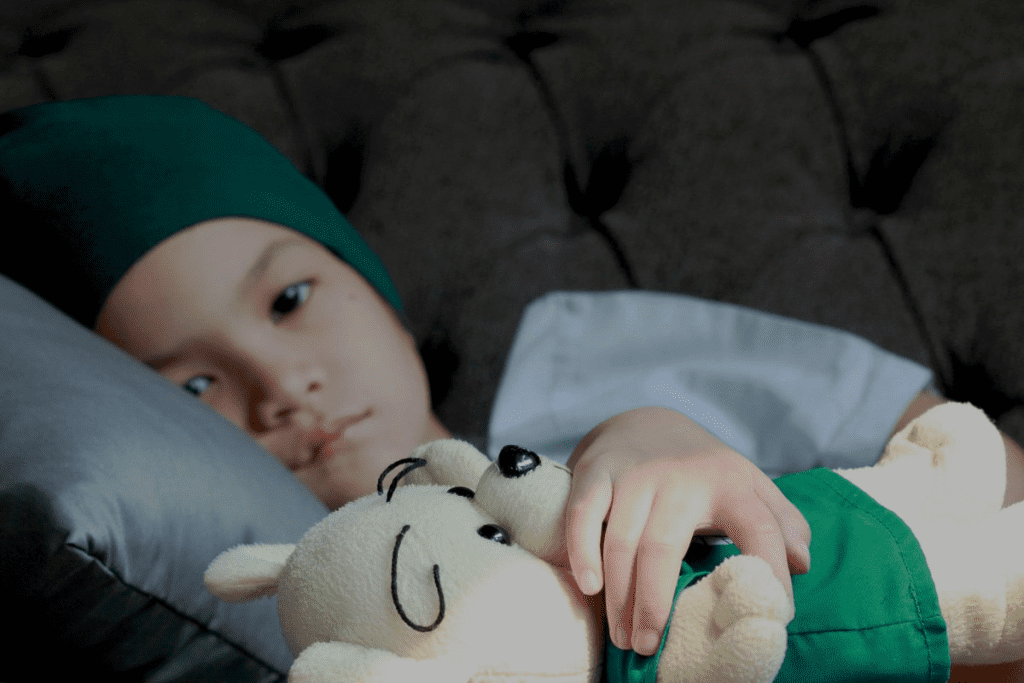Last Updated on October 20, 2025 by
Childhood cancer is a big problem worldwide, hitting nearly 400,000 kids and teens each year. People often ask, why does cancer happen, especially in children, as the causes can be complex and varied. Sadly, while 80% or more of children survive cancer in high-income countries, it’s much worse in poorer places. There, survival rates are below 30% because of late diagnosis and lack of treatment.

We need to understand why childhood cancer happens and how to stop it. By looking at the global issue and talking about new treatments and support, we can help more kids survive. This is our goal for young patients all over the world.
Childhood cancer is a big problem worldwide. It affects kids everywhere, with different outcomes based on where they live and healthcare access.
Every year, about 400,000 kids get cancer. This huge number shows the big problem of childhood cancer globally. We need more awareness and better healthcare to tackle this issue.
Survival rates differ a lot between rich and poor countries. Kids in wealthy areas have an 80% survival rate. But, in poorer areas, it’s only about 30%. This gap is mainly because of less access to early detection and treatment.
Early detection and good treatment are key to saving kids with cancer. If caught early and treated right, many can beat the disease. We must improve global healthcare so all kids get the care they need, no matter where they are.
It’s important to know about the different cancers that can affect kids. Childhood cancer isn’t just one disease. It includes many types, each with its own challenges.
Leukemia is the most common cancer in kids. It’s a blood and bone marrow cancer. It makes abnormal white blood cells, which can harm normal blood cell production.
Early detection and the right treatment are key to fighting leukemia. They help improve survival chances and lower the risk of serious problems.

Brain and central nervous system (CNS) tumors are also common in kids. These tumors can be either benign or malignant. They vary in severity and impact.
The symptoms can be hard to spot because they are subtle and varied. Thanks to new treatments, many kids with these tumors are doing better.
Other cancers like lymphomas, neuroblastoma, and sarcomas also affect kids. Lymphomas are cancers of the lymphatic system. Neuroblastoma starts in the nerve tissue of young children.
Each cancer needs a special treatment plan. This often includes chemotherapy, surgery, and radiation therapy.
Knowing about these cancers is vital for parents, doctors, and researchers. It helps us find better ways to diagnose, treat, and support kids with cancer.
Cancer in kids often comes from a mix of genetic and environmental factors. While we don’t know everything, studies have found several key elements.
Most childhood cancers come from new mutations, not inherited ones. Genetic factors are big in some cancers. Some kids are born with genes that make them more likely to get cancer. A study on the National Center for Biotechnology Information says knowing these genes is key for early treatment.

Environmental factors also play a part in childhood cancer. Things like chemicals and radiation can raise a child’s cancer risk. “The role of environmental exposures in the etiology of childhood cancer is an area of ongoing research,” shows how complex this issue is.
Even with more research, most childhood cancers don’t have a clear cause. This makes it hard to prevent and catch early. We need to keep supporting research to help kids with cancer.
Understanding how genes and environment interact can help lower childhood cancer rates. We must keep studying to find causes and prevent them.
Childhood cancer is often misunderstood, leading to fear and confusion for parents. It’s important to clear up these myths and share accurate information.
Yes, some children are born with cancer due to genetic mutations during fetal development. Genetic conditions can raise a child’s cancer risk. For example, some genetic syndromes increase the risk of certain cancers.
Research shows that childhood cancer cases have slightly increased over the years. But this rise isn’t the same for all types of cancer. The reasons are complex, and better diagnostic tools might play a role.
Parents often worry about what causes childhood cancer. They might think it’s due to environmental factors or their actions. While some exposures can increase risk, most cases have no known cause. Learning the truth can help reduce guilt and fear.
Reducing harmful environmental factors is key in fighting childhood cancer. By understanding and reducing these risks, we can help prevent this disease.
Creating a smoke-free environment is a critical step. Secondhand smoke increases health risks, including cancer. We must protect children from smoke at home, in cars, and in public.
The American Cancer Society stresses there’s no safe level of tobacco smoke. This shows how vital a smoke-free environment is for kids.
Reducing radiation exposure from medical imaging is also important. While imaging is sometimes needed, we should only use it when necessary. New technology allows for lower radiation doses.
We must also limit children’s contact with pesticides and harmful chemicals. These are found in many products and places. Simple choices, like organic produce and eco-friendly cleaners, can help.
By taking these steps, we can greatly reduce environmental risks for childhood cancer. It’s a team effort that needs awareness, education, and action from everyone.
Nutrition is key in preventing childhood cancer. A balanced diet supports health and lowers cancer risk.
A balanced diet is vital for a strong immune system in kids. It should include foods rich in vitamins, minerals, and antioxidants. Foods high in antioxidants, like fruits and veggies, protect cells from damage.
We suggest adding colorful fruits and veggies to kids’ meals. Leafy greens, berries, and citrus fruits are great choices.
Some foods can help fight cancer. These include:
It’s easy to add these foods to meals. For example, use tomatoes in pasta sauces or broccoli in stir-fries.
Keeping a healthy weight is also important. Obesity increases cancer risk. Encourage kids to stay active and eat well.
Supporting healthy habits in kids helps them stay well and reduces cancer risk. It’s good for their overall health.
Vaccinations are key in fighting cancer in kids. They help lower the risk of certain cancers. By getting the right shots, parents can keep their kids safe from cancer.
The Hepatitis B vaccine is a cancer fighter. It stops liver cancer by blocking Hepatitis B infection. Getting the Hepatitis B vaccine is a big step in stopping liver cancer.
The HPV vaccine guards against cancers like cervical and anal cancer. HPV vaccination stops these cancers before they start. It’s vital for parents to see how important HPV shots are for their kids’ health.
Following the right vaccination schedule is key.
This way, parents can protect their kids from cancers that vaccines can prevent.
It’s key to spot the warning signs of childhood cancer early. Early detection can greatly improve a child’s chances of beating cancer. We need to watch for physical and behavioral changes that might mean a serious health problem.
Some physical signs in kids could mean cancer. Look out for ongoing tiredness, unexplained weight loss, and unusual lumps or swelling. Persistent pain, like headaches or bone pain, needs to be checked out. Also, fever, bruising, or bleeding without a clear reason should prompt a doctor’s visit.
Behavioral changes can be early signs of serious health problems in kids. Watch for changes in appetite, mood swings, or feeling unwell. If a child starts to withdraw or gets really irritable, it’s important to find out why.
Regular visits to the pediatrician are key for catching childhood cancer early. These visits help doctors keep an eye on a child’s health and catch any problems early. Keeping up with vaccinations and check-ups is vital for a child’s health.
Knowing the warning signs and making sure kids get regular check-ups can help catch cancer early. This can lead to better treatment and outcomes for kids with cancer.
Children with cancer need advanced treatments and strong support. Cancer treatment is complex. It must cover medical, emotional, and psychological needs of kids and their families.
Multidisciplinary care teams are key to effective cancer treatment. These teams include oncologists, surgeons, and nurses. They work together to create personalized treatment plans for each child.
This approach considers all aspects of a child’s health. It helps from the start of treatment to the end.
New medical research has brought innovative therapies like targeted therapy and immunotherapy. These treatments offer hope for kids with cancer. They are more effective and less invasive.
Joining clinical trials also offers access to the latest treatments. It helps advance cancer care for everyone.
Cancer affects not just the child but the whole family. Psychological support is vital. It helps kids deal with the emotional and psychological effects of cancer.
Organizations like Liv Hospital show how important care is. They offer counseling and therapy. This support helps families face cancer treatment together.
Childhood cancer is a complex issue. Understanding its causes and recognizing warning signs is key. This knowledge empowers parents to make informed health decisions for their kids.
Knowledge is power in the fight against childhood cancer. Parents can create a safe environment and promote healthy lifestyles. They can also stay informed about new medical advancements.
We’ve talked about ways to prevent cancer, like reducing environmental risks and promoting good nutrition. Staying current with vaccinations is also important. These steps help parents protect their children’s health and well-being.
Childhood cancer rates seem to be going up, but they’re not really. Better ways to find and report cancer cases are why it looks like it’s increasing.
Yes, some kids are born with cancer or get it very early. Types like neuroblastoma can be there from birth.
Most childhood cancers have unknown causes. But, genetic changes, environmental factors, and infections might play a part.
Cancer in kids happens when cells grow out of control. This can be because of genetic changes, environmental factors, or both.
Kids get cancer because of a mix of genetic, environmental, and lifestyle factors. Often, there’s no clear reason.
Cancer is caused by many things, not just one. Both genetics and the environment play a role.
Some cancers are there from birth because of genetic changes or other factors during fetal development.
There’s no guaranteed way to stop childhood cancer. But, avoiding harmful environments, staying healthy, and getting vaccinated can help.
Babies can get cancer from genetic changes or other factors. Some cancers are there from birth, while others come later.
Look out for signs like constant tiredness, unexplained weight loss, pain, skin or eye changes, and unusual lumps or swelling.
Treatment involves many steps, like surgery, chemotherapy, and radiation. It’s all about what the child needs based on their cancer type.
Explains that most childhood cancers are caused by mutations (some inherited, many not), environmental exposures (e.g. radiation), but prevention is limited; what families can do (vaccines, avoiding unnecessary exposures).
Describes how vaccines like Hepatitis B and HPV reduce risk of specific cancers, which helps in cancer prevention strategies.
Subscribe to our e-newsletter to stay informed about the latest innovations in the world of health and exclusive offers!